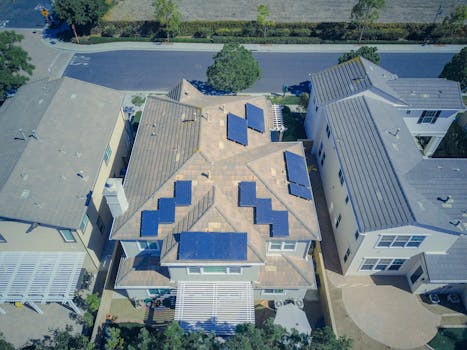“On-Grid vs. Off-Grid Inverters: Powering Your Home with Connection or Independence.”
On-grid and off-grid inverters are essential components in solar energy systems, each serving distinct purposes based on the energy needs and infrastructure of a given location. On-grid inverters, also known as grid-tied inverters, are designed to connect solar power systems directly to the utility grid, allowing for the export of excess energy back to the grid and enabling net metering benefits. In contrast, off-grid inverters operate independently of the utility grid, providing power to standalone systems that rely on battery storage to supply electricity when solar generation is insufficient. This introduction highlights the fundamental differences in functionality, application, and energy management between on-grid and off-grid inverters, which are crucial for determining the appropriate solar solution for various energy scenarios.
On-Grid Inverters: Key Features and Benefits
On-grid inverters, also known as grid-tied inverters, play a crucial role in the integration of solar energy systems with the existing electrical grid. These devices convert the direct current (DC) generated by solar panels into alternating current (AC), which is the form of electricity used by most household appliances and the grid itself. One of the key features of on-grid inverters is their ability to synchronize with the grid’s voltage and frequency, ensuring a seamless flow of electricity. This synchronization allows for the efficient transfer of excess energy generated by solar panels back to the grid, which can be particularly beneficial during peak sunlight hours when energy production is at its highest.
Another significant advantage of on-grid inverters is their ability to maximize energy production through advanced technologies such as maximum power point tracking (MPPT). This feature enables the inverter to continuously adjust its operation to extract the maximum possible power from the solar panels, regardless of changing environmental conditions. As a result, homeowners can enjoy increased energy yields, which can lead to substantial savings on electricity bills. Furthermore, many modern on-grid inverters come equipped with monitoring capabilities, allowing users to track their energy production and consumption in real-time. This transparency not only helps in understanding energy usage patterns but also aids in optimizing the performance of the solar energy system.
In addition to their efficiency and monitoring features, on-grid inverters offer a cost-effective solution for homeowners looking to harness solar energy. Since these inverters do not require batteries for energy storage, the initial investment is typically lower compared to off-grid systems. This affordability makes solar energy more accessible to a broader range of consumers, encouraging the adoption of renewable energy sources. Moreover, many regions offer incentives and rebates for installing solar systems, further enhancing the financial viability of on-grid solutions.
Another noteworthy aspect of on-grid inverters is their contribution to grid stability. By feeding excess energy back into the grid, these inverters help reduce the overall demand on traditional power plants, particularly during peak usage times. This not only supports the grid’s reliability but also promotes a cleaner energy mix by integrating renewable sources into the existing infrastructure. As more homeowners adopt solar energy systems with on-grid inverters, the cumulative effect can lead to a significant reduction in greenhouse gas emissions, contributing to a more sustainable future.
However, it is essential to recognize that on-grid inverters do have limitations. For instance, they are designed to shut down during power outages to protect utility workers and equipment. This means that homeowners relying solely on on-grid systems will not have access to electricity during such events unless they have a backup power solution in place. Despite this drawback, the benefits of on-grid inverters, including their efficiency, cost-effectiveness, and positive impact on the environment, make them an attractive option for many homeowners.
In conclusion, on-grid inverters serve as a vital component in the transition to renewable energy. Their ability to efficiently convert solar energy into usable electricity, coupled with features that enhance energy production and monitoring, positions them as a practical choice for those looking to reduce their reliance on fossil fuels. As technology continues to advance, the role of on-grid inverters in promoting sustainable energy solutions will only become more significant, paving the way for a greener future.
Off-Grid Inverters: Understanding Their Functionality

Off-grid inverters play a crucial role in the functionality of standalone power systems, particularly in remote areas where access to the traditional electrical grid is limited or nonexistent. Unlike their on-grid counterparts, which are designed to synchronize with the utility grid, off-grid inverters operate independently, converting direct current (DC) generated by renewable energy sources, such as solar panels or wind turbines, into alternating current (AC) for household use. This fundamental difference in operation is essential for understanding how off-grid systems function and the unique advantages they offer.
One of the primary functions of off-grid inverters is to manage the energy produced by renewable sources and ensure that it is available for immediate use. When solar panels generate electricity during daylight hours, the off-grid inverter converts this DC electricity into AC electricity, which can then power household appliances. However, since energy production can be intermittent, especially with solar energy, off-grid inverters are equipped with advanced features to handle fluctuations in power generation. They often include built-in battery management systems that store excess energy for use during periods of low production, such as at night or on cloudy days. This capability not only enhances energy reliability but also allows users to maintain a consistent power supply regardless of external conditions.
Moreover, off-grid inverters are designed to be highly efficient, ensuring that as much energy as possible is converted and utilized. Efficiency is particularly important in off-grid systems, where every watt counts. Many modern off-grid inverters boast efficiencies of over 90%, meaning that they waste very little energy during the conversion process. This efficiency is further enhanced by features such as maximum power point tracking (MPPT), which optimizes the energy harvested from solar panels by adjusting the electrical load to match the panel’s output. By maximizing energy capture, off-grid inverters help users make the most of their renewable energy investments.
In addition to energy conversion and management, off-grid inverters also provide essential safety features. They are equipped with protective mechanisms to prevent overcharging of batteries, short circuits, and other potential hazards. These safety features are vital in off-grid applications, where users may not have immediate access to professional assistance in the event of a malfunction. Furthermore, many off-grid inverters come with monitoring capabilities, allowing users to track their energy production and consumption in real-time. This data can be invaluable for optimizing energy use and ensuring that the system operates efficiently.
Transitioning to an off-grid lifestyle often requires careful planning and consideration of energy needs. Off-grid inverters are available in various sizes and configurations, allowing users to select a system that best fits their specific requirements. Whether powering a small cabin or a larger home, the right off-grid inverter can make a significant difference in energy independence and sustainability. As more individuals and communities seek to reduce their reliance on fossil fuels and embrace renewable energy, understanding the functionality of off-grid inverters becomes increasingly important.
In conclusion, off-grid inverters serve as the backbone of independent power systems, enabling users to harness renewable energy effectively. By converting DC to AC, managing energy storage, ensuring efficiency, and providing safety features, these inverters empower individuals to live sustainably and autonomously. As technology continues to advance, the capabilities of off-grid inverters will likely expand, further enhancing their role in the transition to a more sustainable energy future.
Comparing Efficiency: On-Grid vs. Off-Grid Inverters
When considering the efficiency of on-grid and off-grid inverters, it is essential to understand the fundamental differences in their design and functionality. On-grid inverters, also known as grid-tied inverters, are specifically engineered to work in conjunction with the utility grid. They convert the direct current (DC) generated by solar panels into alternating current (AC) that can be fed directly into the grid. This integration allows homeowners to utilize the grid as a backup power source, ensuring that they can draw electricity when their solar production is insufficient. Consequently, on-grid inverters are optimized for maximum efficiency during peak sunlight hours, as they are designed to synchronize with the grid’s voltage and frequency.
In contrast, off-grid inverters operate independently of the utility grid. They are essential components of standalone solar power systems, which are often used in remote locations where grid access is unavailable. Off-grid inverters not only convert DC to AC but also manage battery storage systems, allowing users to store excess energy generated during the day for use at night or during cloudy weather. This added complexity means that off-grid inverters must be equipped with advanced features to ensure efficient energy management, including charge controllers and battery management systems. As a result, while off-grid inverters can be highly efficient in their specific applications, they may not achieve the same peak efficiency levels as their on-grid counterparts during optimal solar conditions.
Moreover, the efficiency of both types of inverters can be influenced by various factors, including temperature, load conditions, and the quality of the components used. On-grid inverters typically boast higher efficiency ratings, often exceeding 95%, due to their streamlined design and the absence of battery management requirements. This high efficiency is particularly advantageous for homeowners looking to maximize their return on investment in solar technology. However, it is important to note that on-grid systems are vulnerable to power outages; when the grid goes down, these inverters automatically shut off to protect utility workers and equipment, which can be a significant drawback for those seeking energy independence.
On the other hand, off-grid inverters, while generally less efficient than on-grid models, provide a unique advantage in terms of energy autonomy. They allow users to harness solar energy without relying on the grid, making them ideal for remote locations or for individuals who prioritize self-sufficiency. The efficiency of off-grid systems can be enhanced through careful system design, including the selection of high-quality batteries and proper sizing of the inverter to match the energy needs of the household. Additionally, advancements in technology have led to the development of hybrid inverters that combine the features of both on-grid and off-grid systems, offering flexibility and improved efficiency.
In conclusion, the choice between on-grid and off-grid inverters ultimately depends on individual energy needs and circumstances. On-grid inverters excel in efficiency and ease of use, making them suitable for urban settings where grid access is reliable. Conversely, off-grid inverters provide essential energy independence for those in remote areas or for users who desire a self-sufficient lifestyle. Understanding these differences in efficiency and functionality is crucial for making informed decisions about solar energy systems, ensuring that users can select the inverter that best aligns with their energy goals and lifestyle preferences.
Cost Analysis: On-Grid and Off-Grid Inverter Systems
When considering the cost implications of on-grid and off-grid inverter systems, it is essential to understand the fundamental differences between these two configurations. On-grid inverters are designed to work in conjunction with the utility grid, allowing homeowners to sell excess energy back to the grid, while off-grid inverters operate independently, relying solely on stored energy from batteries or renewable sources. This distinction significantly influences the overall cost of installation, maintenance, and operation.
To begin with, the initial investment for on-grid systems tends to be lower than that of off-grid systems. On-grid inverters are generally less expensive because they do not require additional components such as batteries or complex energy management systems. The simplicity of on-grid systems allows for a more straightforward installation process, which can further reduce labor costs. In contrast, off-grid systems necessitate a more substantial upfront investment due to the need for batteries, charge controllers, and other equipment to ensure a reliable energy supply. This complexity not only increases the initial costs but also requires careful planning and sizing to meet the energy demands of the household.
Moreover, while on-grid systems may have lower initial costs, it is crucial to consider the long-term financial implications. On-grid systems can benefit from net metering, which allows homeowners to receive credits for excess energy produced. This can lead to significant savings on electricity bills over time, making the overall cost of ownership more favorable. Additionally, many regions offer incentives and rebates for on-grid solar installations, further enhancing their financial appeal. In contrast, off-grid systems do not have the same opportunities for energy credits, and homeowners must rely solely on their stored energy, which can lead to higher operational costs, especially if battery replacements are needed over time.
Furthermore, maintenance costs also differ between the two systems. On-grid inverters typically require less maintenance since they are connected to the utility grid and do not rely on battery storage. The primary maintenance concern is ensuring that the inverter itself is functioning correctly, which can often be monitored remotely. Conversely, off-grid systems require regular maintenance of batteries and other components, which can be both time-consuming and costly. Batteries have a finite lifespan and may need to be replaced every few years, adding to the long-term expenses associated with off-grid living.
In addition to maintenance, the cost of energy storage plays a significant role in the overall expense of off-grid systems. The price of batteries has been decreasing in recent years, yet they still represent a substantial investment. Homeowners must carefully evaluate their energy needs and the capacity of their battery systems to avoid overspending on unnecessary storage. This careful consideration is less of a concern for on-grid systems, where energy is drawn directly from the grid as needed.
Ultimately, the choice between on-grid and off-grid inverter systems hinges on various factors, including initial costs, long-term savings, maintenance requirements, and energy independence. While on-grid systems may present a more economical option in terms of upfront investment and ongoing expenses, off-grid systems offer the allure of self-sufficiency and resilience against grid outages. Therefore, prospective buyers must weigh these financial considerations against their personal energy goals and lifestyle preferences to make an informed decision that aligns with their needs.
Q&A
1. **What is an on-grid inverter?**
An on-grid inverter is a device that converts direct current (DC) from solar panels into alternating current (AC) for use in homes connected to the utility grid, allowing for net metering and energy exchange with the grid.
2. **What is an off-grid inverter?**
An off-grid inverter is a device that converts DC from solar panels or batteries into AC for use in standalone systems that are not connected to the utility grid, providing power independently.
3. **How do on-grid and off-grid inverters handle energy storage?**
On-grid inverters typically do not include energy storage capabilities, as they rely on the grid for power supply, while off-grid inverters are designed to work with battery storage systems to provide power when solar generation is insufficient.
4. **What happens during a power outage with on-grid and off-grid inverters?**
During a power outage, on-grid inverters automatically shut down to protect utility workers and cannot provide power, whereas off-grid inverters continue to supply power from their battery storage, allowing for uninterrupted electricity.
Conclusion
On-grid inverters are designed to connect solar power systems to the utility grid, allowing for net metering and the ability to sell excess energy back to the grid, while off-grid inverters operate independently, providing power to standalone systems without grid connection, often incorporating battery storage for energy management. The primary differences lie in their functionality, energy management capabilities, and reliance on the grid, with on-grid systems focusing on grid interaction and off-grid systems emphasizing self-sufficiency and energy independence.




